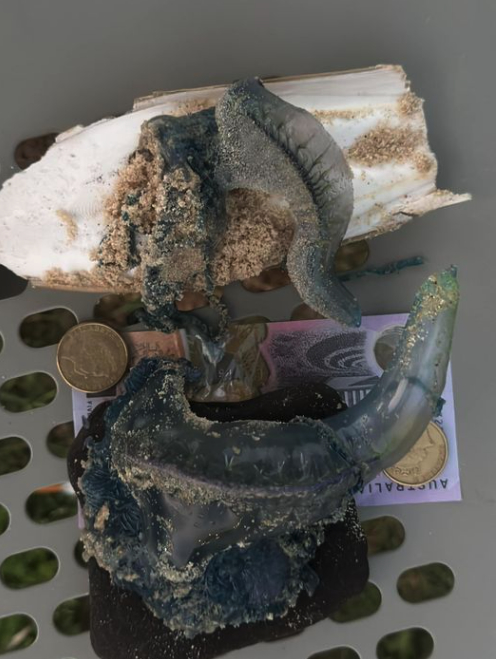Giant bluebottles have hit the beaches of the Sunshine Coast in winter, prompting warnings of a potentially bumper stinger season.
Many beachgoers were surprised to see a variety of stingers on the region’s shoreline in early August.
Tudor Steele spotted a couple of huge bluebottles while walking his dog at Marcus Beach and posted photos on social media, prompting many others to comment on their recent sightings.
“Moby Dick washed ashore this afternoon,” he said.
“Absolute harbingers of death … bigger than a fiver, with an arsenal of stingers as well.”
Meanwhile, Bel Hordyk posted a photo of a stinger she saw near Stumers Creek at Coolum.
“Does anyone know what these little marine life creatures are?” she said.
“About the size of a 20-50 cent piece, flat round base on the bottom with a thin transparent half dome shape on the top, amazing wonders at the beach.”
Lifeguard supervisor Trent Robinson and his colleagues had also noticed a spate of stingers, and he said it could be a sign of things to come.
“We’ve had some really big bluebottles; some of them the size of your hand,” he said.

“It is quite early for bluebottles to be coming but I’d say a lot of that is to do with El Nino and stronger onshore winds, which we are expecting all through summer.
“It will keep us (lifeguards) busy.”
There have been fewer stingers in the region during the past couple of years, but they generally make their impact felt.
“We’ve had a couple of seasons at places like Mooloolaba, which is northerly facing, where we have had up to 150 people a day getting stung,” Mr Robinson said, before suggesting how to best deal with stings.
“When you do get stung in the water, don’t get out of the water straight away,” he said.
“The tentacle is still on you, so if you just put your arm back in the water hopefully it will just detangle itself.
“Or you could rub it with a bit of sand and then get out of the water and wash it with some fresh water and apply ice.
“If the sting’s still there and bad, head home and have a nice warm shower.”
University of the Sunshine Coast PhD candidate Blake Lausen said the bluebottles photographed by Mr Steele were an uncommon find.
“It is very unusual for bluebottles, Physalia utriculus, to be washing up in winter, or at this size,” he said.
“However, it is not unprecedented. Strong easterly winds for several weeks, even in winter, will cause the appearance of the blue fleet.”

He also said they could inflict some pain.
“Large bluebottles are the most dangerous of the blue fleet and can inflict very painful stings that can last for hours,” he said.
“But their venom is non-lethal and their presence doesn’t usually cause the closing of beaches.”
But he said the recent spate of stinger sightings did not necessarily mean there will be an influx during summer.
“It is not an indicator of a bad stinger season, as the appearance of bluebottles is entirely dependent on winds and ocean currents,” he said.
Mr Lausen also confirmed the identity of the stinger that Ms Hordyk showed on social media.
“Accompanying the large bluebottles washing up on shore are a large amount of Velella velella, also known as ‘by-the-wind sailors’,” he said.
Mr Lausen is conducting a research project on the venom of bluebottles and similar creatures with UniSC professor Scott Cummins.
Mr Cummins said the two pictures that were posted on social media were “part of the blue fleet”.
“It includes various blue marine animals, like bluebottles, jellies and snails, that float around together and can wash up on the beaches,” he said.
“The bluebottles seem to be most annoying to those at the beach due to their powerful sting.”
Like stories that inform, connect and celebrate the Sunshine Coast? So do we. Join an independent local news revolution by subscribing to our FREE daily news feed at the bottom of this article.





